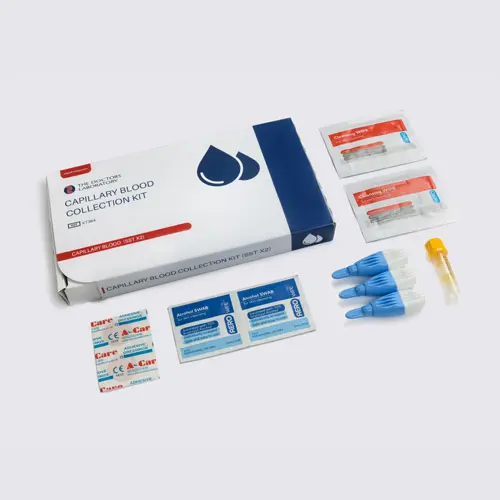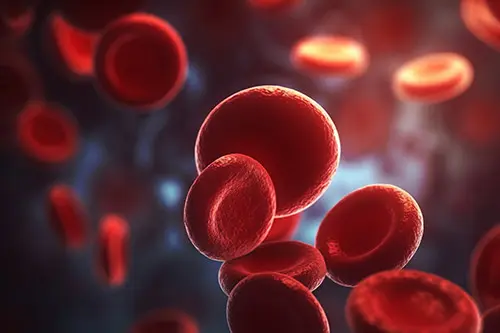What's the difference between a finger-prick and venous blood test?
Published
Key Article Takeaways
- A finger-prick sample comes from your capillaries whereas a venous sample comes from a vein.
- A venous sample can be used for pretty much any blood test but you need a healthcare professional to take the blood.
- A finger-prick sample isn’t an option for every test but you can do it yourself at home.
- If you’ve got both options, it’s a balance between cost and convenience vs. ease.
Blood tests are probably the most powerful tool we have to understand what’s going in our bodies. From looking at your genes, to cancer screening and figuring out if your organs and systems are in good health, blood tests are one of the cornerstones of modern medicine.
Blood tests come in two main flavours. You can do a finger-prick or “capillary” blood test or you can do a venous blood test. But what’s the difference between the two and, more importantly, which type should you choose?
What’s a finger-prick or capillary blood test?
One of the interesting side-effects of the COVID-19 pandemic is that we’re all a lot more familiar with testing ourselves. Many of us did self-collection blood tests at home to see if we had coronavirus antibodies. We pricked a finger to collect blood in a small tube and sent it to a lab for analysis.
This finger-prick blood sample is also called a “capillary” sample because the blood actually comes from the small network of blood vessels in your skin called capillaries.

But capillary blood samples can be used to test for lots more than just COVID antibodies. For example, you can check your cholesterol, risk of diabetes, [essential] vitamins(/tests/iron-vitamin-d-and-b12-deficiency-blood-test) and even whether you have coeliac disease. All from a thimbleful of blood you collect yourself at home - pretty neat!
What’s a venous blood test?
But there is another way to collect blood that nearly all of us will have experienced at some point - a venous blood test. In this test, a healthcare professional places a small needle into one of your veins (usually in your arm) to collect the blood.

It’s called a venous blood test because the blood comes from a vein. Your capillaries actually drain into your veins so your veins are “downstream” of your capillaries. Anything you can test for with a finger-prick blood test, you can also test for with a venous blood test. But, as we’ll see, venous blood tests also allow you to test for a whole lot more than you could do with a capillary sample.
Which is better - a finger-prick or venous blood test?
Ok, this is a slightly unfair question! You can’t really say that one is “better” than the other. Both finger-prick and venous blood tests have their pros and cons so the answer is. “it depends”.

The major ”pro” of venous blood samples is that you can do pretty much any blood test with them whereas capillary blood samples are only accurate for some tests. One of the main reasons for this is that to collect a finger-prick sample, we have to “milk” the blood out of the capillaries and this can sometimes damage some of the fragile blood cells. Damaged blood cells can interfere with some tests which stops us being able to do them.
Another advantage of venous blood samples is that you usually get more blood compared to a finger-prick sample. Veins are like rivers whereas capillaries are like streams. Getting plenty of blood means you can run more tests in one go because each test uses a certain amount of blood.
Ok, so venous blood tests are better right? Well… the trouble with venous blood tests is that you need someone who knows what they’re doing to take the blood for you. This often means having to go to a clinic. Also, some people really don’t like needles. The beauty of a finger-prick test is that you can do it yourself, at home, whenever it’s convenient for you. And there’s no needle. This is a major pro, particularly if you’re busy, testing frequently or want to minimise costs.
So, if I have the option, should I go for a finger-prick or venous blood test?
At Selph, we’ve partnered with some clinics to give you the choice, when possible, of doing a venous blood sample for your blood test or using one of our simple, at home finger-prick test kits. As we’ve said, finger-prick collection isn’t suitable for some tests so you won’t always see this option.

When you do have the choice of finger-prick or venous blood collection the main deciding factors are probably cost and convenience vs. ease.
Having a professional take the venous blood test for you is easy and you don’t have to think about it but you’ll usually have to travel to a clinic and there’ll be a small charge for the service. On the other hand, if you’re happy to go it alone, our finger-prick collection kits are provided free of charge and you can do the test whenever you like.
So there you have it, everything you need to know about the differences between finger-prick and venous blood tests. Now all you have to do is figure out what to test…
Get tips on better health
Sign up to our emails on the better way to better health.
We'll keep you up-to-date with the latest research, expert articles and new ways to get more years of better health.

